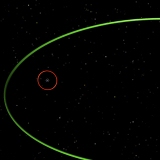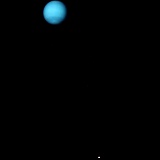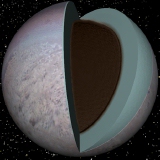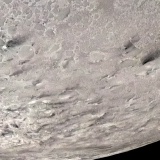 |
||
|
Voyager
view of Triton, the most reflective moon in the Solar System.
|
||
| TRITON - MOON OF NEPTUNE | ||
| Triton in Greek mythology was a god of the sea, the son of Poseidon (The Greek equivalent of the Roman god Neptune). Triton was portrayed as having the head and body of a man and the tail of a fish. | ||
| It was discovered by the British astronomer William Lassell in 1846 less than a month after Neptune itself was discovered. | ||
| Orbit | ||
| Triton orbits Neptune in an inclined, circular, and retrograde orbit (opposite to the direction of the planet's rotation). The inclination of Triton's orbit is 157.34o. Triton completes an orbit in just under 6 days at an average distance of 330,000 kilometres above Neptune's cloud tops. | ||
| As Triton orbits Neptune in a retrograde direction, it is thought that it could have originated elsewhere in the Solar System. Before capture by Neptune it would have had a very elliptical or eccentric orbit. It may have taken Neptune a thousand million years to circularise Triton's original path. | ||
 The orbits of Nereid and Triton. |
 Voyager's wide-angle view of Triton in orbit around Neptune. |
|
| Physical properties | ||
| Triton has a diameter of 2720 kilometres, making it the largest of Neptune's moons. It is only slightly smaller than our Moon. The next Neptunian moon in size is just 420 kilometres. The others are even smaller and are more like asteroids than moons. | ||
| Triton has a density of about 2100 kg m-3. This relatively high density further suggests that it did not form near Neptune but from solar nebula material in the Kuiper belt. | ||
 Comparison between Triton and Earth's Moon. |
||
| Interior | ||
| As Voyager 2 flew by Triton it experienced a gravitational tug from the moon. This information allows scientists to deduce that Triton has an interior that is a mixture of rock and ice. The ice accounts for about 25% of the material. This is consistent with Triton's density. Triton is far less icy than many other satellites of the outer planets. | ||
| Although Triton's interior was probably differentiated when it was incorporated into the Neptunian system, tidal perturbations by Neptune and its other moons may have provided additional heating. A warm interior would enable dense materials (rock) to move towards the core and lighter materials (ice) to find their way to the surface to form a mantle and an outer crust. The extra heat ensured that Triton was completely differentiated and, very likely, drove geological processes for most of its history. | ||
 Cross-section through Triton. |
||
| Magnetic field | ||
| No magnetic field has been detected. | ||
| Atmosphere | ||
| Triton has a very thin atmosphere. The atmospheric pressure at Triton's surface is very low, between 10 and 15 millionths of a bar. Earth's atmospheric pressure at the surface is about 1 bar, so Triton's atmospheric pressure is a tiny 1/70,000th that of Earth's. Nitrogen ice forms wispy clouds a few kilometres above the surface, and at lower levels some methane (CH4) has been detected. The abundance of methane is only about 0.01% that of the nitrogen. | ||
| Triton has an unusual seasonal cycle, and a delicate balance between the surface constituents and the atmosphere. Recent measurements even suggest that Triton is experiencing global warming. | ||
| More about Triton's atmosphere and seasons | ||
 Triton's tenuous atmosphere can be seen above the moon's limb. |
||
| Surface | ||
| The surface of Triton is very bright, with an albedo of 0.7 to 0.8 (a perfectly reflective surface has an albedo of 1.0). This makes it one of the most reflective objects in the Solar System. | ||
| The Voyager spacecraft revealed Triton to have a most unusual surface, with a complex geological history. Triton's surface is active - there are geysers spewing gas and dark particles into the atmosphere, and ascending plumes that suddenly change direction before drifting hundreds of kilometres downwind. | ||
| More about Triton's surface | ||
 Dark streaks, up to hundreds of kilometres long, on Triton's surface. |
||
|
|
||